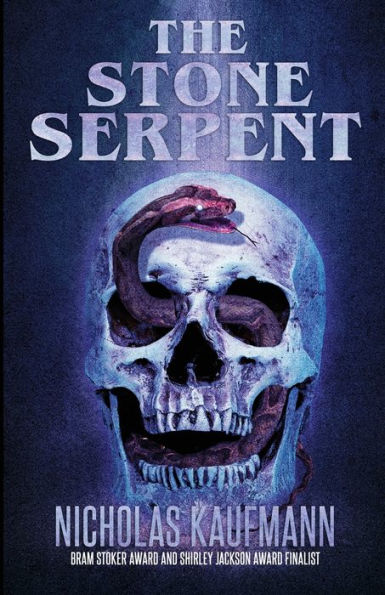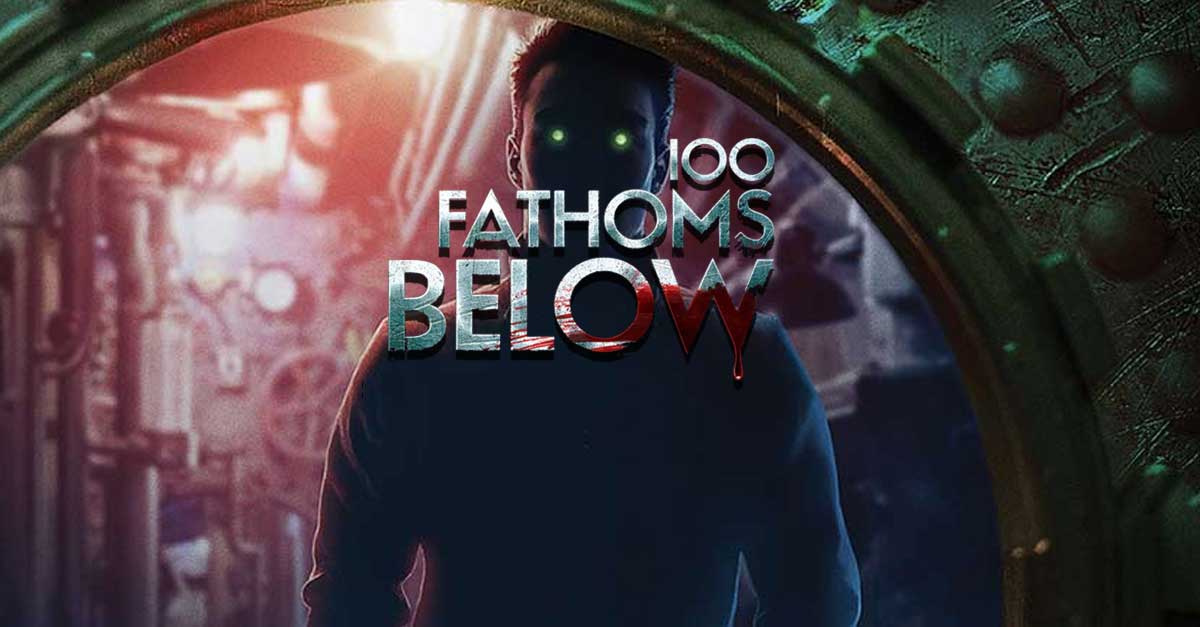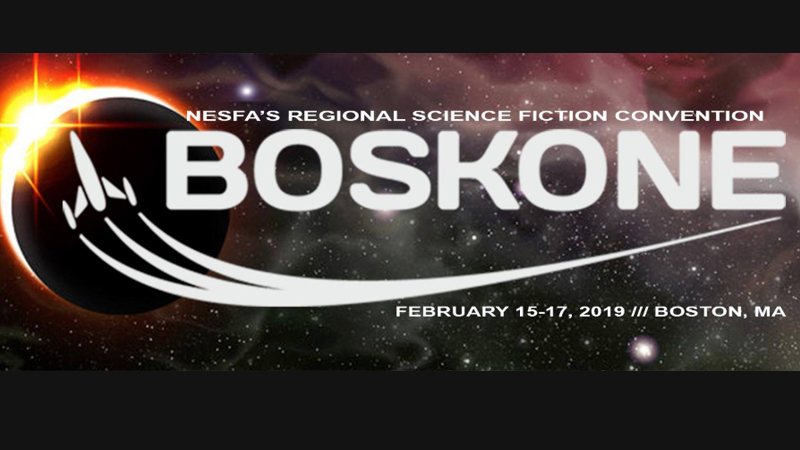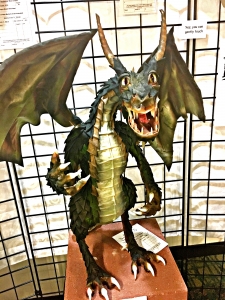 I discovered Boskone just last year. Talk about arriving late to the party, but better late than never.
I discovered Boskone just last year. Talk about arriving late to the party, but better late than never.
My graduate program was wrapping up in less than a year, and I didn’t want my growth as a writer to stagnate. Since I had (have) ambitions of breaking into the publishing industry as an author of excellent stories, attending a science fiction and fantasy (SFF) convention seemed a smart idea.
Without question, I achieved my primary goal of listening to a bunch of panel discussions that imparted heaps of tips, tricks, and sound reminders. But, once the panels were over and the “social” stuff started up, I felt like an awkward outsider. You can read about my (mis)adventures here. Even hiding in a corner, though, I observed the real benefit of attending Boskone. Community.
FOR THE CREATIVES OF THIS WORLD, COMMUNITY IS KEY
 I’m a creative writer, but my beloved is a visual artist, as is my mother, and I’m friends with a voice actor and a musician. Trying to make it, professionally, in any art-related field is not for the faint of heart. It can wear you down if you’re not careful. That’s why finding and joining supportive communities is essential. For me–an aspiring author of fantasy, science fiction, and horror fiction–Boskone is one of the best, most supportive communities in New England.
I’m a creative writer, but my beloved is a visual artist, as is my mother, and I’m friends with a voice actor and a musician. Trying to make it, professionally, in any art-related field is not for the faint of heart. It can wear you down if you’re not careful. That’s why finding and joining supportive communities is essential. For me–an aspiring author of fantasy, science fiction, and horror fiction–Boskone is one of the best, most supportive communities in New England.
Therefore, despite a vicious head-cold that struck me hard on Thursday, I spent this past weekend in Boston attending the 56th annual Boskone convention (Boskone 56 for short). Thank Thor for modern medicine. Dosed to the max with DayQuil, RobitussenDM, and NyQuil, I had a great time.
The panels were excellent, the panelists entertaining and insightful. This year, however, I focused on meeting and chatting with the other writers, readers, and gamers. And authors, agents, and editors. That last group doesn’t love being stalked by aspiring authors, so I courted them purposefully but respectfully.
Here’s how the Boskone 56 experience went for me. This is the first in a three part post. Yeah, there was that much going on at Bostkone this year, and I only saw a fraction of it all.
FRIDAY – DAY 1 OF THE FUN
 Beloved and I opted to get a room in the convention hotel this year rather than commute each day. Good call. If I can, I’ll be staying at the hotel again next year. Taking an elevator up to my room at the end of the day made the evening activities far more enjoyable (although I still wasn’t pulling super late nights because of my cold).
Beloved and I opted to get a room in the convention hotel this year rather than commute each day. Good call. If I can, I’ll be staying at the hotel again next year. Taking an elevator up to my room at the end of the day made the evening activities far more enjoyable (although I still wasn’t pulling super late nights because of my cold).
[Quick tip to anyone who attends next year and stays at the hotel: request a room on the lowest floor possible. Sure, the 12th floor gave us a beautiful view of the Boston skyline, but the hot water didn’t seem to get up to us very well, and lukewarm showers aren’t a thing I enjoy.]
PANEL #1: EDITING YOUR MANUSCRIPT FOR SUBMISSION
 The first panel discussion I attended was Editing Your Manuscript for Submission. I took copious notes as author/editor Auston Habershaw and Joshua Bilmes, president of Jabberwocky Literary Agency, discussed the value of writing groups, how to know when it’s time to stop editing and start submitting, and the importance of brevity in one’s writing.
The first panel discussion I attended was Editing Your Manuscript for Submission. I took copious notes as author/editor Auston Habershaw and Joshua Bilmes, president of Jabberwocky Literary Agency, discussed the value of writing groups, how to know when it’s time to stop editing and start submitting, and the importance of brevity in one’s writing.
Q: How do you get the right distance from a manuscript so you can see it again?
Autson: Put it away for months and start working on something else. Short fiction can act as a great palette cleanser.
Q: Who do you give your revised manuscripts to?
Auston: Beta readers, my agent. Writing groups are okay, but you have to be careful with them. They risk getting stale, becoming an echo chamber without anyone in the group realizing it. Author Tim Powers once told me, ‘You should be the worst person in your writing group.’
Q: [To Joshua Bilmes] What are you most likely to tell Auston not to do when reading and editing one of his manuscripts?
Joshua: If you start a book in a particular style, with a particular voice, you’ve made a promise to the readers that needs to be fulfilled. You can’t change course mid-way through. The readers will get whiplash. They’ll feel betrayed.
Q: When is a manuscript “good enough” to start querying?
Auston: Get it to a place where the big stuff all lines up. Plot stuff, style, voice. Then go through and do line edits. Then give it to beta readers you trust. Work in suggestions as you will. Then, you’re ready.
Joshua: It’s “done” when I ask for it from him in “Track Changes” mode. But, it’s still not done because an editor will buy it and will want more changes.
Q: [To Joshua Bilmes] What do you look for? What should writers avoid?
Joshua: Overwriting. You have to watch the adjectives. Cut it to the bone. And watch your descriptions of facial expressions. Every author seems to have a certain facial expression that they use over and over again. The dialogue tag said is like water. It’s unobtrusive and essential. Any substitutes are overused. Grin, laugh, nod, shrug, sigh. It slows everything down. It distracts.
Q: Tips for learning voice?
Auston: Read poetry! Anything by Langston Hughes.
“Don’t use thirteen words when ten will do.” – Joshua Bilmes.
“You should be the worst person in your writing group.” – Auston Habershaw. [meaning the least-skilled writer.]
You better believe I was taking notes!

KAFFEEKLATSCH #1: MARSHALL RYAN MARESCA
At 6 pm I headed to the galleria to catch my first Kaffeeklatsch of the weekend, hosted by fantasy author Marshall Ryan Maresca.
Turns out, it was his very first time hosting one, and when he saw me approaching the table, he must have thought, uh-oh. Here comes that woman I caught staring at me multiple times from the far side of the lobby last year. Creep alert.
 To prove myself a non-creep, I made a point of shaking his hand and introducing myself instead of just staring. A couple of other aspiring writers joined us as well as one established author: S. L. Huang. The fifty-minute session flew by as the group discussed the process by which his books (all twelve of them) came into existence, the struggles of balancing writing with raising children, and our various writing habits.
To prove myself a non-creep, I made a point of shaking his hand and introducing myself instead of just staring. A couple of other aspiring writers joined us as well as one established author: S. L. Huang. The fifty-minute session flew by as the group discussed the process by which his books (all twelve of them) came into existence, the struggles of balancing writing with raising children, and our various writing habits.
And then it was time to grab some dinner before the next Friday night activity began.
BROAD UNIVERSE: A COMMUNITY FOR WOMEN WRITERS
At 9 pm, we headed to a multi-author reading session hosted by Broad Universe, an international, non-profit organization dedicated to supporting women writers and editors of SFF, horror, and other speculative genres.
 Among the talented women who read from published works and works-in-progress were Elaine Isaac, Juliana Spink Mills, and Joanna Weston, among others.
Among the talented women who read from published works and works-in-progress were Elaine Isaac, Juliana Spink Mills, and Joanna Weston, among others.  Dianna Sanchez gave away a copy of the 2017 Young Explorer’s Adventure Guide, an SFF short fiction anthology aimed for middle-grade readers. My hand went up so fast it broke the sound barrier! I’m happy to report that my middle-grader told me over breakfast yesterday morning that they’re two stories in and enjoying it.
Dianna Sanchez gave away a copy of the 2017 Young Explorer’s Adventure Guide, an SFF short fiction anthology aimed for middle-grade readers. My hand went up so fast it broke the sound barrier! I’m happy to report that my middle-grader told me over breakfast yesterday morning that they’re two stories in and enjoying it.
THE BOSKONE ART SHOW IS NOT TO BE MISSED!
At 10 pm, Beloved and I headed back down to the Galleria to stroll the art exhibit. This portion of Boskone is where visual artists, illustrators, sculptors, and crafters display their best work. While all of the art at Boskone was exceptional, one vendor’s creations blew my mind!!
Kimberly Leach, of Kimberly’s Creations. She makes paper mache fantasy creations. I know, I know. You’re thinking, paper mache? Really?
Oh, folks. You have no idea. The photos I took (and I took many) fail to do these pieces of art justice. For Freya’s sake, please click the link and explore her website. I’m seriously going to tweet these at Cressida Cowell (wrote the How to Train Your Dragon series that spawned the movies).
Dragon 1
Image 1 of 6
Photograph of a paper mache dragon created and displayed by Kimblerly Leach at Boskone 56
Paper Mache, people. And when I asked how she stumbled upon this epic talent, her answer? I was looking for something to do with my granddaughter. As if it was no big deal, these crafty masterpieces. She’s a genius. Genius!!
By 10:30 pm I couldn’t breathe through my nose anymore and was starting to drag, so Beloved and I called it a day. All hail the powers of NyQuil.
In my next post, I’ll share summaries of all the panel discussions, kaffeeklatsches, and author readings I attended, starting with: Are Villains Necessary? Spoiler alert: they very much are!
Are you thinking about attending Boskone next year? What do you most want to know about the convention?
 I recently had the pleasure of reading Nicholas Kaufmann’s newest horror novel, “The Stone Serpent.” This sequel to Kaufmann’s 2021 novel “The Hungry Earth” takes place a year after the events of the first book and follows the main character, Dr. Laura Powell, as she tries to re-establish some semblance of normalcy in her life. The story’s premise (which you can read over on Goodreads) was a lot of fun, and the fast pace kept me engaged from start to finish.
I recently had the pleasure of reading Nicholas Kaufmann’s newest horror novel, “The Stone Serpent.” This sequel to Kaufmann’s 2021 novel “The Hungry Earth” takes place a year after the events of the first book and follows the main character, Dr. Laura Powell, as she tries to re-establish some semblance of normalcy in her life. The story’s premise (which you can read over on Goodreads) was a lot of fun, and the fast pace kept me engaged from start to finish.
 As with his other books, “The Stone Serpent” is packed with interesting and accurate scientific facts and descriptions. That said, the science sometimes felt wedged into scenes without good reason. Often, descriptions felt included just for the sake of serving up a creepy or interesting fact. More than once, I wondered why a small-town medical examiner would know about so many facts unrelated to medicine. Nevertheless, all those not-necessarily-needed scientific facts were so interesting (and morbid) that I enjoyed their inclusion regardless.
As with his other books, “The Stone Serpent” is packed with interesting and accurate scientific facts and descriptions. That said, the science sometimes felt wedged into scenes without good reason. Often, descriptions felt included just for the sake of serving up a creepy or interesting fact. More than once, I wondered why a small-town medical examiner would know about so many facts unrelated to medicine. Nevertheless, all those not-necessarily-needed scientific facts were so interesting (and morbid) that I enjoyed their inclusion regardless. 



 I’m a creative writer, but my beloved is a visual artist, as is my mother, and I’m friends with a voice actor and a musician. Trying to make it, professionally, in any art-related field is not for the faint of heart. It can wear you down if you’re not careful. That’s why finding and joining supportive communities is essential. For me–an aspiring author of fantasy, science fiction, and horror fiction–Boskone is one of the best, most supportive communities in New England.
I’m a creative writer, but my beloved is a visual artist, as is my mother, and I’m friends with a voice actor and a musician. Trying to make it, professionally, in any art-related field is not for the faint of heart. It can wear you down if you’re not careful. That’s why finding and joining supportive communities is essential. For me–an aspiring author of fantasy, science fiction, and horror fiction–Boskone is one of the best, most supportive communities in New England. Beloved and I opted to get a room in the convention hotel this year rather than commute each day. Good call. If I can, I’ll be staying at the hotel again next year. Taking an elevator up to my room at the end of the day made the evening activities far more enjoyable (although I still wasn’t pulling super late nights because of my cold).
Beloved and I opted to get a room in the convention hotel this year rather than commute each day. Good call. If I can, I’ll be staying at the hotel again next year. Taking an elevator up to my room at the end of the day made the evening activities far more enjoyable (although I still wasn’t pulling super late nights because of my cold). The first panel discussion I attended was Editing Your Manuscript for Submission. I took copious notes as author/editor
The first panel discussion I attended was Editing Your Manuscript for Submission. I took copious notes as author/editor 
 To prove myself a non-creep, I made a point of shaking his hand and introducing myself instead of just staring. A couple of other aspiring writers joined us as well as one established author:
To prove myself a non-creep, I made a point of shaking his hand and introducing myself instead of just staring. A couple of other aspiring writers joined us as well as one established author:  Among the talented women who read from published works and works-in-progress were
Among the talented women who read from published works and works-in-progress were 
